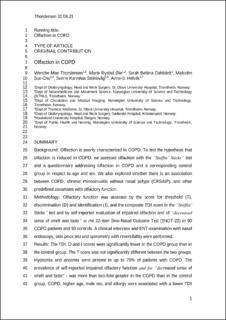| dc.description.abstract | Background: Olfaction is poorly characterized in COPD. To test the hypothesis that olfaction is reduced in COPD, we assessed olfaction with the "Sniffin' Sticks" test and a questionnaire addressing olfaction in COPD and a corresponding control group in respect to age and sex. We also explored whether there is an association between COPD, chronic rhinosinusitis without nasal polyps (CRSsNP), and other predefined covariates with olfactory function. Methodology: Olfactory function was assessed by the score for threshold (T), discrimination (D) and identification (I), and the composite TDI score in the "Sniffin' Sticks" test and by self-reported evaluation of impaired olfaction and of "decreased sense of smell and taste" in the 22-item Sino-Nasal Outcome Test (SNOT-22) in 90 COPD patients and 93 controls. A clinical interview and ENT-examination with nasal endoscopy, skin prick test and spirometry with reversibility were performed. Results: The TDI, D and I scores were significantly lower in the COPD group than in the control group. The T score was not significantly different between the two groups. Hyposmia and anosmia were present in up to 79% of patients with COPD. The prevalence of self-reported impaired olfactory function and for "decreased sense of smell and taste" - was more than two-fold greater in the COPD than in the control group. COPD, higher age, male sex and allergy were associated with a lower TDI score, while CRSsNP was not associated with the TDI score. Conclusions: COPD is associated with olfactory dysfunction and the underlying mechanisms for this dysfunction should be elucidated. | en_US |
